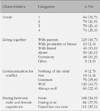Abstract
Purpose
This investigation was carried out to understand how various sex role identities in female college students affect attitudes on the sexual violence.
Methods
From September 1, 2008 to September 30, 2008, the questionnaire composed of instruments developed by Park (2002) and Shin (2004) was distributed to 295 female college students. Frequency, χ2 test, ANOVA were conducted for data analysis using SPSS/WIN 10.0 Program.
Results
In the four kinds of sex role identity, Androgyny type was most common (30.7%). There was significant difference between the sex role identity and communication for conflict. Subjects have positive attitudes on the sexual violence. And there was significant difference between the sex role identity and attitudes on the sexual violence.
Figures and Tables
References
1. Baek ER, Lee EM. A study on current status of and recommendations for sexual violence counselling for women with disabilities. J Asian Women. 2006; 45(1):53–100.
3. Cohen J. Statistical power analysis for the behavioral science. 2nd ed. New Jersey: Lawrence Erlbaum Associates;1988.
4. Houng KM. The study of the relationship between sexual identities and attitudes about sexual violence of female university students. Daegu: Catholic University of Daegu;2005. Unpublished master's Thesis.
5. Jang SH. A study on sexual violence consciousness of adolescence: Focusing on high school students in gwang-ju/chonnam area. Gwangju: Chonnam University;2003. Unpublished master's Thesis.
6. Kathleen T. Essays featuring: Masculinity-feminity: Society's difference dividend. 1998. Retrieved September 5, 2006. from http://web2.airmail.net/ktrig246/out_of_cave/mf.html.
7. Kim JI, Do KS, Lee JH. The cognitive representation of sexuality and sexual violence. Korean J Youth Couns. 2003; 11(1):56–67.
8. Kim SN, Choi SO, Shin KI, Lee JJ. The relationships between sex-role identity and the meaning in life for a matriarch. Korean J Women Health Nurs. 2002; 8(2):190–200.

9. Kho HJ, Lee EJ. Differences between gender role identity and sexual attitude among college students. Korean J Women Health Nurs. 2007; 13(3):192–200.

10. Kwon SH, Kim SN, Park CH, Seo YS, Sung MH, An SH, et al. Women and health. Seoul: Soomoonsa;2006.
11. Lee JH, Kim KH, Choi MH, Kim HY, Oh KS, Kim KS. A study on gender-role identity and cyber delinquency in high school students. J Korean Acad Psychiatr Ment Health Nurs. 2010; 19(1):76–84.

12. Lee WS. Analysis of sexual violence counseling of sexual violence relief centers. J Soc Sci. 2000; 9:171–195.
13. Nam MJ. A study on rape myth according to sexual identities. Busan: Pusan National University;2004. Unpublished master's thesis.
14. Nam SY, Yoo EG, Park KE. A study on the type attitude toward the sexual violence. J Korean Acad Womens Health Nurs. 2000; 6:5–17.
15. O'Donohue W, Downs K, Yeater EA. Sexual harassment: A review of the literature. Aggress Behav. 1998; 3(2):111–128.
16. Oswald PA. An examination of the current usefulness of the Bem sex-role inventory. Psychol Rep. 2004; 94(3):1331–1336.

17. Park KJ. Research on sex-role identity and career decision-making styles. Jeju: Cheju National University;2002. Unpublished master's thesis.
18. Ryu EJ, Seo JS, Ham MY, Park YR. Sex-role identity in adolescents and its relation to anxiety, depression and suicidal ideation. J Korean Acad Psychiatr Ment Health Nurs. 2006; 15(2):136–143.
19. Sadler AG, Booth BH, Nielson D, Doebbeling BN. Health-related consequences of physical and sexual violence: Women in the military. Obstet Gynecol. 2000; 96:473–480.

20. Shin GS. The effect of prevention education for the adolescent on the attitude change relevant to sexual abuse. Daegu: Daegu University;2004. Unpublished master's Thesis.
21. Spence JT, Helmreich R. The many faces of androgyny: A replay to Alocksley and Colten. J Pers Soc Psychol. 1979; 37:1031–1046.
22. Sung MH, Lim YM. Discriminant factors of attitude pattern toward sexual violence of college women. Korean J Women Health Nurs. 2009; 15(4):312–319.





 PDF
PDF ePub
ePub Citation
Citation Print
Print







 XML Download
XML Download